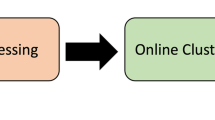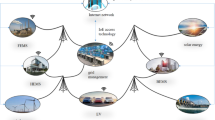Abstract
Monitoring of human behavior in the natural living habitat requires a hidden yet accurate measurement. Several previous attempts showed, that this can be achieved by recording and analysing interactions of the supervised human with sensorized equipment of his or her household. We propose an imperceptible single-sensor measurement, already applied for energy usage profiling, to detect the usage of electrically powered domestic appliances and deduct important facts about the operator’s functional health. This paper proposes a general scheme of the system, discusses the personalization and adaptation issues and reveals benefits and limitations of the proposed approach. It also presents experimental results showing reliability of device detection based on their load signatures and areas of applicability of the load sensor to analyses of device usage and human performance.
Access this chapter
Tax calculation will be finalised at checkout
Purchases are for personal use only
Similar content being viewed by others
References
Augustyniak, P., Smolen, M., Mikrut, Z., Katoch, E.: Seamless tracing of human behavior using complementary wearable and house-embedded sensors. Sensors 14(5), 7831–7856 (2014)
Augustyniak, P., Kantoch, E.: Turning domestic appliances into a sensor network for monitoring of activities of daily living. J. Med. Imaging Health Inf. 5, 1662–1667 (2015)
Bagala, F., et al.: Evaluation of accelerometer-based fall detection algorithms on real-world falls. PLoS ONE 7, e37062 (2012)
Belley, C., Gaboury, S., Bouchard, B., Bouzouane, A.: Activity recognition in smart homes based on electrical devices identification. In: Proceedings of the 6th International Conference on Pervasive Technologies Related to Assistive Environments, Rhodes, Greece, pp. 1–8 (2013). doi:10.1145/2504335.2504342
Bobek, S., Porzycki, K., Nalepa, G.J.: Learning sensors usage patterns in mobile context-aware systems. In: Ganzha, M., Maciaszek, L.A., Paprzycki, M. (eds.) Proceedings of the Federated Conference on Computer Science and Information Systems FedCSIS 2013, Krakow, Poland, 8–11 September 2013, pp. 993–998. IEEE (2013)
Brdiczka, O., Crowley, J.L., Reignier, P.: Learning situation models in a smart home. IEEE Trans. Syst. Man Cybern. Part B Cybern. 39(1), 56–63 (2009)
Bujnowski, A., Skalski, L., Wtorek, J.: Monitoring of a bathing person. J. Med. Imaging Health Inform. 2, 27–34 (2012)
Lai, Y.-X., Lai, C.-B., Huang, Y.-M., Chao, H.-C.: Multi-appliance recognition system with hybrid SVM/GMM classifier in ubiquitous smart home. Inf. Sci. 230, 39–55 (2013)
Lapalu, J., Bouchard, K., Bouzouane, A., Bouchard, B., Giroux, S.: Unsupervised mining of activities for smart home prediction. In: Proceedings of the 4th International Conference on Ambient Systems, Networks and Technologies, Procedia Computer Science, vol. 19, pp. 503–510 (2013)
Li, C., Hua, T.: Human action recognition based on template matching. Procedia Eng. 15, 2824–2830 (2011)
Luhr, S., West, G., Venkatesh, S.: Recognition of emergent human behaviour in a smart home: a data mining approach. Pervasive Mob. Comput. 3, 95–116 (2007)
Maitre, J., Glon, G., Gaboury, S., Bouchard, B., Bouzouane, A.: Efficient appliances recognition in smart homes based on active and reactive power, fast fourier transform and decision trees. Papers from the 2015 Association for the Advancement of Artificial Intelligence Workshop, pp. 24–29 (2015)
Robben, S., Krse, B.: Longitudinal residential ambient monitoring: correlating sensor data to functional health status. In: Proceedings of the 7th International Conference on Pervasive Computing Technologies for Healthcare (PervasiveHealth), pp. 244–247 (2013)
Ros, M., Cullar, M.P., Delgado, M., Vila, A.: Online recognition of human activities and adaptation to habit changes by means of learning automata and fuzzy temporal windows. Inf. Sci. 220, 86–101 (2013)
Ruzzelli, A.G., Nicolas, C., Schoofs, A., OHare, G.M.P.: Real-time recognition and profiling of appliances through a single electricity sensor. In: Proceedings of the 7th Annual IEEE Communications Society Conference on Sensor, Mesh and Ad Hoc Communications and Networks, Boston, MA, USA, 21–25 June 2010, pp. 1–9 (2010)
Vu, L., Do, Q., Nahrstedt, K.: Jyotish: constructive approach for context predictions of people movement from joint Wifi/Bluetooth trace. Pervasive Mob. Comput. 7, 690–704 (2011)
Zoha, A., Gluhak, A., Imran, M.A., Rajasegarar, S.: Non-intrusive load monitoring approaches for disaggregated energy sensing: a survey. Sensors 12(12), 16838–16866 (2012). doi:10.3390/s121216838
Acknowledgement
This scientific work is supported by the AGH University of Science and Technology in years 2015–2016 as a research project No. 11.11.120.612.
Author information
Authors and Affiliations
Corresponding author
Editor information
Editors and Affiliations
Rights and permissions
Copyright information
© 2016 Springer International Publishing Switzerland
About this paper
Cite this paper
Augustyniak, P. (2016). Detection of Behavioral Data Based on Recordings from Energy Usage Sensor. In: Rutkowski, L., Korytkowski, M., Scherer, R., Tadeusiewicz, R., Zadeh, L., Zurada, J. (eds) Artificial Intelligence and Soft Computing. ICAISC 2016. Lecture Notes in Computer Science(), vol 9693. Springer, Cham. https://doi.org/10.1007/978-3-319-39384-1_12
Download citation
DOI: https://doi.org/10.1007/978-3-319-39384-1_12
Published:
Publisher Name: Springer, Cham
Print ISBN: 978-3-319-39383-4
Online ISBN: 978-3-319-39384-1
eBook Packages: Computer ScienceComputer Science (R0)




